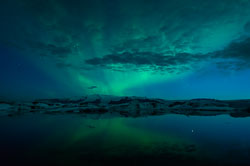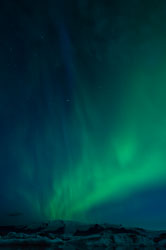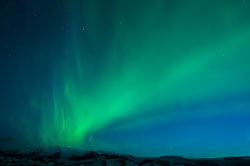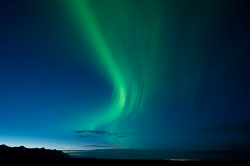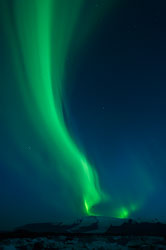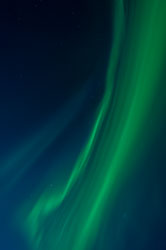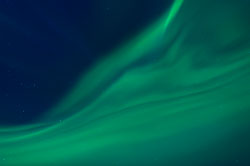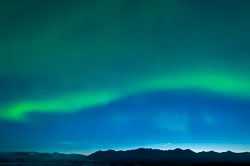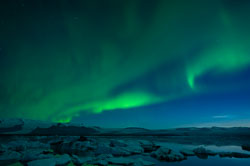Iceland's Summertime Auroras
Nighttime Photography with the Leica S007 by David Knoble on October 14, 2018

This article was first published in Viewfinder, Volume 51, No 4 of the International Leica Society, LHSA. This image was featured on the cover
The grey-green streams above slowly snaked from the glacial mountain across our small knoll overlooking the Jökulsárlón Lake at one o’clock in the morning. I had tightened the tripod legs and closed the grips on the arca-swiss mount securing my camera. My coffee was in the thermos resting underneath the tripod and my wool cap pulled over my ears. Powered on, I checked the settings one more time, ISO, custom white balance, lens aperture and long shutter speed. Too dark to meter I used a recently learned rule of thumb.
Click. After pushing the remote shutter button, I watched the display slowly count down, 8.. 7.. 6. Then, realizing I was bitting my lower lip, I watched the noise cancelling count again, 5.. 4.. 3. In all, sixteen seconds went by and the LCD screen lit up with a preview. Mouth open in awe, I saw a series of green streaks with bright white stars shining through and a reflection on the ice filled lake below. My first photograph of the Aurora, or the northern lights. The awe quickly spread to a wide-mouthed grin. The adrenaline was moving and coffee was not needed even at this late hour.
I clicked again, looking up. The grey-green lines were more pronounced as the dance had begun, but nothing like the color captured on the digital sensor. The sky was moving like the snake coming out of a charmer’s basket, weaving back and forth, stretching across the sky, horizon to horizon. Everyone in the group said something different, but they were all one-word descriptions of having made the first image. Glancing back at the camera, 3.. 2.. 1. I looked at the screen while unlocking the tripod head and changing the angle and direction for better framing. Tightening with one hand, I pressed the remote with the other.
I let the camera record what it could see with the medium-format S series 24mm lens (19mm equivalent) and I soaked the rest in putting the images into a permanent folder inside my head. I think I said out loud, “I feel like a child in a candy store.” I quickly calculated the time for each image, 16 seconds results in about 4 images per minute. The aurora waits for no-one so the challenge was to take as many photographs as I could, but not miss the spikes and ebbs that played out before us while waiting for a noise cancelling routine.
Someone quietly shouted, “look behind you!” The horizon on the other side had stripes with distinct lines between them. Swivel. Click. 8.. 7.. 6. The snake in the sky was multiplying and spreading out. Again, “Look behind you!” At this point, we were all pointed in different directions. I finally said, “The lake is zero and the mountain range behind us is 180. Call it and we’ll all have a frame of reference.” It worked and we even excitedly burst out with a “90” every now and then as overhead became the show’s main attraction.
For almost three hours I recomposed, press the shutter, waited, oohed and awed at the LCD screen while I recomposed and took the next shot. Gathering up my equipment as the morning twilight began erasing traces of nature’s magnificent light-show, I headed back to load up images and sleep. Cars were beginning to pull in as we left, presumably getting ready for sunrise. As I watched them through the window of our vehicle, I could not help but think that they had missed the show. A sunrise, beautiful in it’s own right, would now forever hold second-place my world.
The aurora (based on the Northern Lights Centre) is actually formed by collisions of electrically charged particles from the sun as they enter the earth’s atmosphere. Seen above the magnetic poles of the earth, northern lights are called Aurora borealis and southern lights, Aurora astralius. Probably most interesting is scientists belief that the northern lights and the southern lights are mirrored copies with similar shapes, movements and designs.
The lights in the Aurora are the results of atmospheric gases colliding with charged particles from our sun’s atmosphere. The color of the light tells us which gasses are interacting with the solar particles. The most common, and the one we saw, is a yellowish-green glow consisting of lower altitude oxygen molecules about 60 miles above the earth. More rare, the red glow Aurora results from interactions with high-altitude oxygen up to 200 miles above the earth. Blue and purplish-red Auroras stem from Nitrogen.
Around 1880 scientists believed the Aurora resulted from sunspot activity. This was confirmed in the 1950’s through work with the University of Alaska at Fairbanks. There they used balloons and measuring devices to study the atmosphere providing a decade long accumulation of data.
Think of the sun as a spinning top in the center of our solar system. Temperatures in the millions of degrees Celsius above surface of the sun cause gases to collide with explosive forces. These massive and forceful collisions split the atoms apart, throwing charged electrons and protons out into space through holes in the sun’s magnetic field. These fast-moving charged particles are known as the solar winds.
The magnetic field of the earth causes most of the particles to bounce off into space, protecting our home. However, the north and south poles have the weakest magnetic fields, so some of the particles get through, colliding with the atmospheric gases and producing the Aurora. While it is hard to imagine standing on the ground looking up, the moving strands of excited gas molecules generally occupy the space between 50 miles and 400 miles above the surface of the earth.
All of these images were taken in southern Iceland during the summer months. The conditions have to be just right, including a clear sky, no light pollution from man-made lights or the sun, and strong solar winds. Summer-time in Iceland has very short periods of dark night-skies and even then the horizon stays bright from the sun that just barely sets. Over a ten day period, we tried three times to photograph the Aurora and were only successful this one night.
I was part of a small group in a photography workshop led by the Leica Store Miami. In a future article I will share some day-time images of Iceland, a truly magnificent landscape full of its own natural colors. I will also share the benefits I have found in attending photography workshops, no matter the size and scope.

